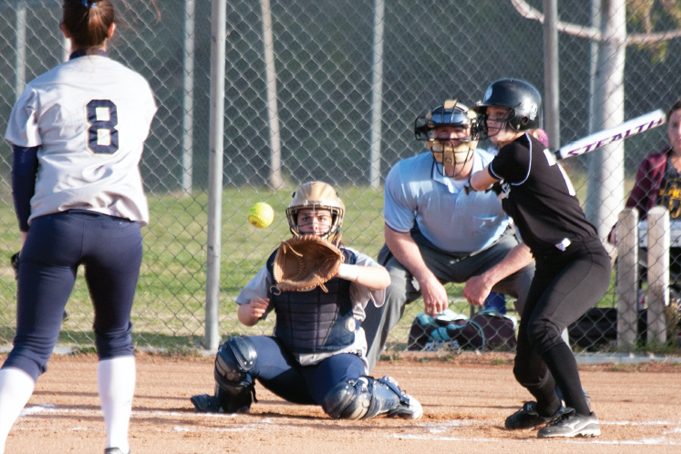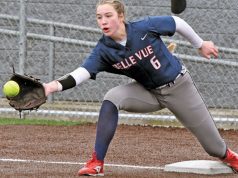Any fast-pitch softball umpire is familiar with the slot position when working a game as the plate umpire: assuming a heel-toe stance behind the catcher, aligned slightly inside the inside corner of the plate and outside the perimeter of the strike zone.
The rationale for this position, as explained in the various softball organizations’ umpire manuals, is to enable the plate umpire to see the entire plate and the ball as it moves from the pitcher’s hand to the catcher’s glove and to be able to accurately judge whether the ball passed through or out of the strike zone. As the USA Softball umpire manual notes, “Being in the correct slot and set position on both sides of the plate gives you an unobstructed view of the strike zone on every pitch from the same angle.”
But as any umpire knows from game experience, being able to see the plate and strike zone from the slot can become more complicated by the positioning of the catcher and/ or the batter. Sometimes the physical size of the catcher and batter can make it more difficult to achieve an unobstructed view from the slot position. Or perhaps it is a catcher who throws left-handed and lines up differently than a right-hander. If the catcher has a tendency to raise from her crouch as she receives the pitch, she can interfere with the umpire’s view at the last instant.
When these situations come into play, the umpire often must make adjustments to maintain an unobstructed view of the strike zone. Several longtime umpires have each offered insight about how to ensure ball-strike calls remain consistent regardless of what the batter or catcher does.
“You can’t call what you can’t see,” said Steve DiFuria of Ardmore, Pa., who has works in NCAA Divisions II and III along with high school competition. “If the catcher blocks me from seeing an inside pitch, it’s a ball. If you have to, you explain it (the catcher’s movement) to the coach. ‘If you want that inside pitch (to be called a strike), tell the catcher not to slide over too much.’ “You have to push yourself to see all four corners of the plate. … Working the plate is about being consistent and confident. If you call a pitch one way in the first inning, you’ve got to call it that way the whole game.”
For Mike Girouard of Yorba Linda, Calif., a key aspect of any adjustment an umpire makes in the slot position is being able to keep the strike zone in perspective. He points out the importance of positioning your head at the top of the strike zone in relation to the batter when going to the set position in the slot.
“When everyone (batter and catcher) is squeezing the slot, the only thing you can do is look over the catcher to see the delivery of the pitch,” said Girouard, a 20-year veteran umpire who oversees training for the 130-member Orange County (Calif.) High School Unit umpire organization and also is on the instructional staff for USA Softball of Southern California.
“You must remember you have now raised your view of the strike zone, to keep you from calling one out of the zone. … You can’t let a stance (by the batter or catcher) change what you have to do,” Girouard said. “We need to set up the same way, so it doesn’t change your perspective of the zone now as the batter and catcher move forward or backward. I adjust with them.”
The discipline to maintain focus while making adjustments in the slot position is equally important, as noted by Jim Stewart of Burlington, N.J. One of his techniques is to reinforce in his mind whether a pitch is a strike or ball before making his verbal call. The slight delay helps him with call accuracy.
“You want to call every single pitch the same way, no matter what,” said Stewart, who has 20 some years of experience, including many years in NCAA Division I. “I’m in the same (slot) position each time. I face the plate at a slight angle and am absolutely set before the ball is released and stay set until it hits the (catcher’s) glove.
“I can’t dictate if the batter moves or the catcher flinches. If I have to adjust, I’ll move just above the catcher’s helmet. I move up so I can see the ball drop over the plate. … The only thing I care about is (that) one pitch.”
When in the slot position, the plate umpire also must be aware of the catcher’s positioning and the possibility of a pickoff throw to first base or third base. Girouard said he is careful to avoid interfering with the catcher when he sets up in the slot position. When working behind a left-handed throwing catcher, umpires have to be attuned to the differences from the more typical right-handed catcher.
“The catcher’s throwing hand or motion does sometimes change how close to the catcher you are due to their snap pickoffs throws,” said Girouard, who has worked the 2015 Special Olympics World Games, an ASA National Championship, the California State Junior College Championship and has 20 years of NCAA experience. “We need to observe that and with runners on base adjust our depth with the catcher to not interfere with the throw.”
What's Your Call? Leave a Comment:
Note: This article is archival in nature. Rules, interpretations, mechanics, philosophies and other information may or may not be correct for the current year.
This article is the copyright of ©Referee Enterprises, Inc., and may not be republished in whole or in part online, in print or in any capacity without expressed written permission from Referee. The article is made available for educational use by individuals.


















